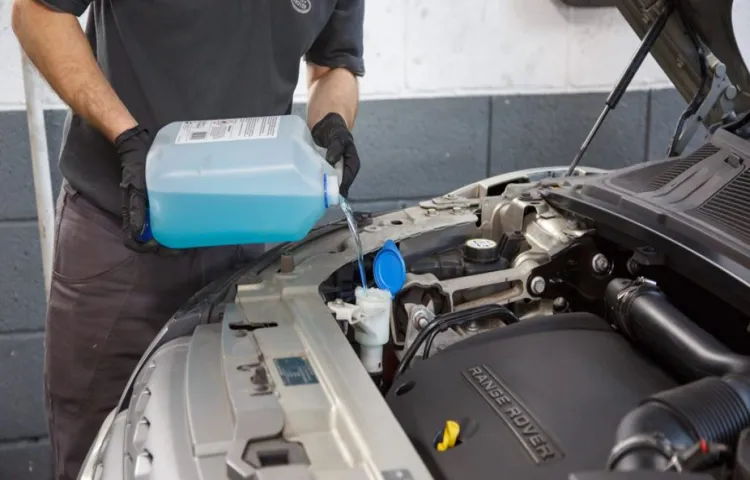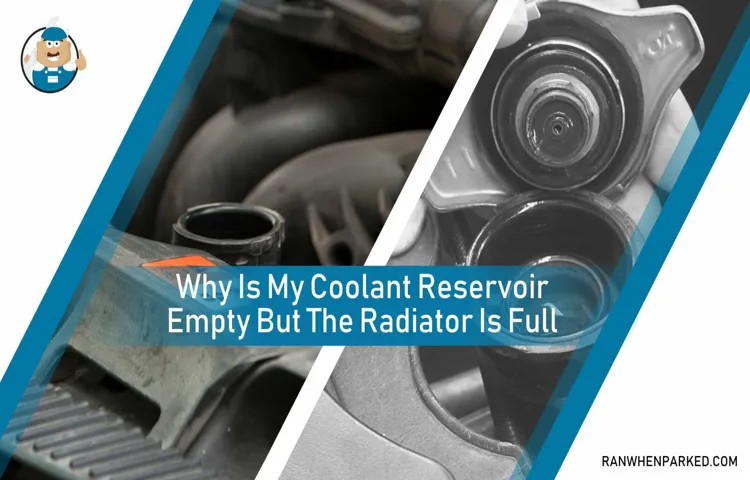Have you noticed that your car’s coolant reservoir is mysteriously empty? Don’t panic, as this is a common issue that many car owners face, and it could be caused by several factors. The coolant system is vital in maintaining the engine’s temperature and preventing overheating, which can lead to severe damage and costly repairs. If you find yourself wondering why your coolant reservoir is empty, you’ve come to the right place.
In this blog, we’ll explore the potential reasons for an empty coolant reservoir and what you can do to remedy the problem. So, let’s dive in and explore this mystery together!
Table of Contents
Explanation of the Coolant Reservoir
If you’re wondering why your coolant reservoir is empty, there could be a few reasons. One possibility is that there’s a leak in your cooling system and the coolant is escaping somewhere. Another possibility is that your engine is overheating and the coolant is being consumed at a faster rate than normal.
In either case, it’s important to address the issue as soon as possible, as driving with low or no coolant can lead to serious engine damage. The coolant reservoir is an important component of the cooling system, as it allows for the expansion and contraction of the coolant as the engine heats up and cools down. It’s important to check the coolant level in the reservoir regularly and top it off as needed to ensure that your engine stays cool and runs smoothly.
If you’re not sure why your coolant reservoir is empty, it’s always a good idea to take your vehicle to a trusted mechanic for an inspection.
What is coolant?
What is Coolant? If you’ve ever opened the hood of your car, you’ve probably seen a white plastic tank with a hose leading to the radiator. That’s the coolant reservoir, and it’s an essential part of your vehicle’s cooling system. Coolant, also known as antifreeze, is a mixture of water and chemicals designed to regulate the temperature of your engine.
It works by circulating through the engine and transferring heat to the radiator, where it’s cooled before making its way back through the system. The chemicals in the coolant also help prevent rust and corrosion, and maintain proper pressure in the cooling system. Without coolant, your engine would quickly overheat and suffer serious damage.
So, it’s important to check your coolant level regularly and inspect the reservoir for any leaks or cracks. Keeping this in mind, always make sure you use the recommended coolant type and mix it with the appropriate amount of water to ensure optimal engine performance.

What is the purpose of a coolant reservoir?
Coolant reservoir A coolant reservoir, also known as an overflow tank or expansion tank, is an essential component of the cooling system in a car. Its primary purpose is to provide additional coolant to the system as needed, ensuring the engine stays at a consistent operating temperature. When the engine heats up, the coolant expands and increases in pressure, which is where the reservoir comes in.
The excess coolant flows into the reservoir, preventing the system from becoming overfilled. As the engine cools down, the pressure decreases, and the coolant is drawn back into the system from the reservoir. This cycle continues as the vehicle is in use.
The reservoir is usually transparent, allowing drivers to check the level of the coolant visually. Keeping the reservoir topped up to the correct level is crucial for maintaining the system’s efficiency and preventing overheating, which can cause significant damage to the engine. In summary, a coolant reservoir is a simple but crucial component of a car’s cooling system that helps maintain the engine’s temperature at a safe and constant level.
Possible Reasons for an Empty Reservoir
If you find that your coolant reservoir is empty, there are several potential reasons why this may be the case. One of the most common explanations is a coolant leak somewhere in the system. This could be due to a cracked hose or a damaged radiator, for example.
Another possibility is that your engine is running too hot, causing the coolant to evaporate rapidly. You might also have a clogged or malfunctioning coolant pump that isn’t properly circulating the fluid through the system. Finally, it’s possible that you simply haven’t been topping off the reservoir regularly enough, and it has gradually become empty over time.
Regardless of the cause, it’s important to address an empty coolant reservoir as soon as possible to prevent engine overheating and damage. So, if you are wondering why is the coolant reservoir empty, it’s time to start investigating.
Coolant Leak
If you notice that your car’s coolant reservoir is empty, the most likely culprit is a coolant leak. Coolant is a vital component of your car’s engine, as it regulates the temperature to prevent overheating. When there is a leak, the coolant can escape and cause serious problems for your vehicle.
There are several reasons why your coolant reservoir might be empty. One common cause is a damaged hose or connection. If the hose or connection is damaged, the coolant can escape and cause a leak.
Another possibility is a cracked radiator, which can also result in a loss of coolant. Additionally, a faulty water pump can cause the coolant to leak out and lead to an empty coolant reservoir. It’s crucial to address this issue immediately to prevent any long-term damage to your vehicle.
If you suspect a coolant leak, it’s best to have your car checked by a professional mechanic to determine the cause and necessary repairs.
Overheating Engine
An overheating engine can be a cause for concern, but an empty reservoir can make the situation even worse. One possible reason for an empty reservoir could be a leak in the cooling system. The system may have developed a crack or puncture, causing coolant to leak out and allowing the engine to overheat.
Another possible reason could be a faulty radiator cap. A worn or damaged cap can allow coolant to escape and cause the reservoir to dry out. Additionally, a broken water pump can lead to an empty reservoir.
The pump is responsible for circulating coolant throughout the engine, and if it fails, the engine can quickly overheat. If you notice that your reservoir is always low or empty, it’s important to have your vehicle inspected by a professional mechanic. Ignoring the problem could lead to costly repairs or even engine failure.
Faulty Reservoir Cap
If you’ve noticed that your car’s coolant reservoir is always running low, there could be a number of reasons why this is happening. One of the possibilities is a faulty reservoir cap. This part of your car’s cooling system is responsible for keeping the coolant contained and pressurized, preventing it from boiling or evaporating.
If the cap is damaged or not sealing properly, the coolant may leak out or evaporate, leaving your reservoir empty and causing your engine to overheat. So if you’re experiencing low coolant levels, it’s definitely worth checking your reservoir cap to make sure it’s functioning properly. If it’s damaged, replace it as soon as possible to avoid any further damage to your engine.
Improper Maintenance
Improper Maintenance When it comes to an empty reservoir, there are several possible reasons. One of the most common is improper maintenance. If the water level starts to decrease dramatically, it could be a sign that the reservoir is not being maintained properly.
This could be due to a number of things, such as a clogged filter or a broken pump. A clogged filter will prevent water from flowing smoothly, while a broken pump will not be able to properly circulate the water. Additionally, if the reservoir is not cleaned regularly, debris can accumulate, leading to blockages and decreased water flow.
It is important to perform routine maintenance on your reservoir to keep it functioning properly and prevent any issues. By investing in regular maintenance, you can ensure that your reservoir stays full and your water quality remains high.
Signs of a Low Coolant Reservoir
If you have noticed that the coolant reservoir of your vehicle is empty, there may be a few reasons for it. First and foremost, a leak in the system could be the culprit. This could be caused by a variety of issues, such as a damaged hose or a crack in the radiator.
Additionally, a faulty radiator cap could also lead to the coolant evaporating and escaping into the atmosphere. Another possible cause could be a blown head gasket, which could cause the coolant to mix with the engine oil, leading to engine damage or failure. If you notice that your engine is running hot or overheating, it is important to check the coolant level immediately and consult a mechanic if necessary.
Remember, maintaining a consistent level of coolant in your vehicle is essential for keeping it operating smoothly and preventing costly damage in the long run. If you are unsure why your coolant reservoir is empty, it is always best to consult a professional for advice.
Dashboard Warning Lights
As a driver, it’s essential to pay attention to your car’s dashboard warning lights, especially the ones that indicate low fluid levels. A common dashboard warning light is the low coolant reservoir warning. This indicates that your car’s coolant level is low and needs to be replenished.
The coolant is a fluid that circulates through your car’s engine to help regulate the engine temperature. Running the car with a low coolant level can cause extensive engine damage, leading to costly repairs. Therefore, once you see the low coolant warning light, stop the car in a safe spot and let the engine cool down, then check the coolant level.
If the coolant level is low, top it up with a 50/50 mixture of coolant and water. But if the low coolant light continues to come on, it could indicate other issues such as a leak in the coolant system, a failed thermostat, or a water pump failure. Be sure to have your car inspected and repaired promptly to avoid any damage to your vehicle.
Remember, as a responsible driver, taking care of your car’s maintenance needs is critical to ensuring a safe and smooth ride.
Engine Temperature Gauge
If you’ve noticed that your engine temperature gauge is reading on the high side or experiencing engine overheating, it could be a sign of a low coolant reservoir. The engine temperature gauge is a crucial component of your vehicle’s instrumentation, as it offers insight into the engine’s health. When the temperature gauge starts to rise above normal levels, it could indicate that the engine is overheating, which could lead to serious engine damage and expensive repairs.
The coolant reservoir is responsible for maintaining the engine’s optimal operating temperature and needs to be accurately filled to prevent engine overheating. Suppose you notice a visible decrease in the coolant reservoir level; in that case, it could signal a more significant problem that requires immediate attention from your mechanic. Ignoring the warning signs of a low coolant reservoir could result in costly repairs or, even worse, a total engine failure.
So, make sure to keep an eye on your engine temperature gauge and top up your coolant reservoir regularly to keep your vehicle running smoothly and avoid any unexpected breakdowns.
Conclusion
Well, it seems that the coolant reservoir has decided to take a vacation without letting us know! Maybe it just needs a break from all the heat and pressure. Or, perhaps it’s been indulging in some wild parties with the radiator and forgot to refill itself. Either way, it’s time to give it a stern talk and remind it of its important job in keeping our engine cool.
After all, nobody wants hot-headed engines, right?”
FAQs
What could be the possible reason that the coolant reservoir is empty?
The possible reasons for an empty coolant reservoir could be leakage in the cooling system, overheating of the engine, or a faulty radiator cap.
How often should I check the coolant level in the reservoir?
Ideally, you should check the coolant level in the reservoir once a month when the engine is cool.\
Can an empty coolant reservoir damage the engine?
Yes, an empty coolant reservoir can cause the engine to overheat, leading to severe damage to the engine parts.
What are the signs of an overheated engine?
The signs of an overheated engine include the temperature gauge rising above normal, steam or smoke coming from the engine, and strange noises.
How can I check the cooling system for leaks?
You can check the cooling system for leaks by examining the hoses, radiator, water pump, and thermostat for any signs of damage or leakage.
Can I drive my car with an empty coolant reservoir?
It is not recommended to drive a car with an empty coolant reservoir as it can result in engine damage and breakdown.
What is the proper way to refill the coolant reservoir?
The proper way to refill the coolant reservoir is to mix the coolant and distilled water as per the manufacturer’s instructions and fill it till the recommended level.



